Strained yogurt is a type of thickened yogurt that is regularly enjoyed throughout the Middle East and Mediterranean. It is eaten plain as a dip, and also used in cooking because it does not curdle at higher temperatures. The process of straining yogurt creates Greek yogurt (the popular, high-protein thickened yogurt sold in stores) and labneh (an even thicker yogurt that has the consistency of soft cream cheese). In this post I will show you how to strain yogurt at home; it’s a very simple process with delicious and healthful results.
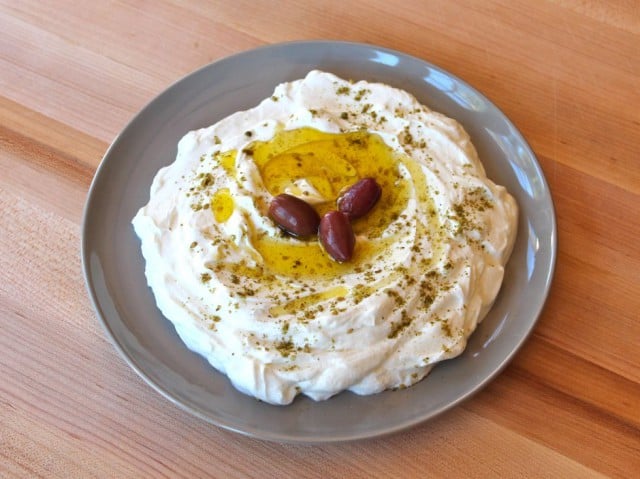
Yogurt has been a staple on the continent of Asia for over a thousand years. While we know that yogurt is ancient, the origins of the dish are a bit unclear. The word yogurt has a Turkish origin because the food found its way to Western Europe through Turkey and the Balkans. According to the Oxford Companion to Food, “Yogurt is one of the fermented milk foods whose origins are probably multiple. It is easy to imagine how, in parts of C. and W. Asia, unintended fermentation of milk could have produced something like yogurt, and that people would have noticed that this would keep for much longer than fresh milk, besides tasting good.”
The nomadic tribes of Western Asia stored milk in animal skins, where is would naturally coagulate and acidify. This was likely the way yogurt was discovered, a far cry from the colorful plastic tubs sold in grocery stores today.
I find straining yogurt to be a great cost-effective technique. Buy a large tub of plain yogurt and you’ve got several tasty possibilities! The process is super easy, and you probably already have the tools to do it in your kitchen. This blog will walk you through the process.
Here are a few things to keep in mind. Straining yogurt will reduce the volume of the yogurt because you’re removing liquid. If you’re thickening the yogurt to use in a recipe (like when a recipe calls for Greek yogurt or labneh), start with more yogurt than the recipe requires. The volume will be reduced by more than half depending on how long you strain it, so plan accordingly. If a recipe calls for ½ cup of strained yogurt, you might want to start with 1 ½ cups to be safe. It’s not an exact science, but err on the side of straining more to make sure you end up with the proper amount. You can always snack on the leftovers. 🙂
Save the liquid (known as whey) that collects in the bowl; it’s filled with nutrients, can be used as a milk substitute in baked goods (breads, scones, biscuits) or to add nutrition to smoothies and protein shakes. The whey will add a mild cheesy flavor to anything you’re using it in. Keep it refrigerated, and don’t use it if it’s been in the fridge for longer than 6 months or has an “off” smell.
Strained yogurt has a rich, creamy flavor that can be used to create dips, spreads, and parfaits. This naturally thickened yogurt is high in protein and calcium. It’s also lower in sugar and carbs than traditional yogurt, making it a good choice for diabetics and people on low carb diets. I much prefer strained yogurt to traditional yogurt– it’s a healthy treat you can feel good about. Enjoy!
Recommended Products:
We are a participant in the Amazon Services LLC Associates Program, an affiliate advertising program designed to provide a means for us to earn fees by linking to Amazon.com and affiliated sites. As an Amazon Associate I earn from qualifying purchases.
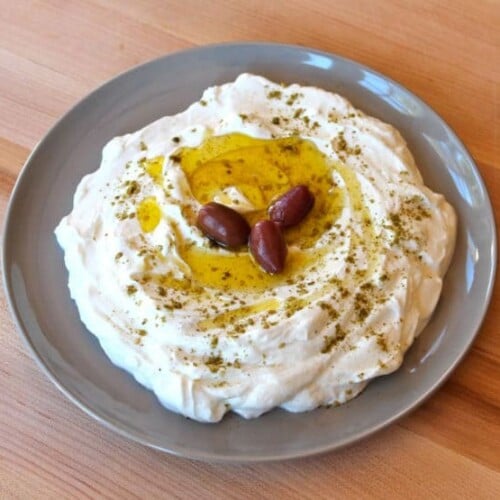
How to Strain Yogurt
Ingredients
- 2 cups plain yogurt - any fat content , more or less as needed
- 1/8 teaspoon salt , optional, or to taste - for labneh
NOTES
Instructions
- Assemble the tools. Place your colander over your bowl.

- Cut the cheesecloth into 18-inch rectangles to form 6 to 8 layers of cloth. Line colander with the cheesecloth.

- Scoop yogurt into the middle of the cheesecloth.

- Gather up the sides of the cheesecloth to form a bundle, and tie it at the top with the twine or string. Do not squeeze the bundle, just let it rest inside the colander. The bowl below will catch the excess liquid.

- If using muslin or a thin dish towel, line the colander with one layer of cloth and proceed with filling with yogurt and tying, just as you would with cheesecloth. Any thin, tightly knit fabric will work. I've even heard of people using a very clean pillowcase to line the colander. Don't use a thick kitchen towel, it will absorb too much of the yogurt during the straining process.

- If using a coffee filter, line the colander with the filter. You want the base of the colander covered with a single layer of filter. Depending on what type of filter you use, the size of your colander, and/or how much yogurt you want to strain, you may need more than one filter to achieve this.

- Place the yogurt in the middle of the filter(s). Cover the yogurt surface with plastic wrap (plastic touching the yogurt).

- Place the colander, bowl, and yogurt inside the refrigerator and let the excess liquid strain into the bowl through the colander. Check after 1 hour to make sure the liquid that is dripping into the bowl is thin and not too white. It should be slightly milky, with no chunks of white in it. If the liquid has a lot of white stuff in it, your cheesecloth is not thick enough, which means you’re losing yogurt instead of liquid. Wrap a few more layers of cheesecloth around the bundle. If the liquid is clear, you're good to go.

- The longer you strain the yogurt, the thicker it will be. To make plain yogurt into Greek yogurt, strain overnight (10-12 hours) to 48 hours. Check consistency every 12 hours and stop straining when you reach the consistency you like.

- To make plain yogurt into rich, thick labneh cheese* (aka yogurt cheese), let is strain for 48-72 hours. Stir in salt as desired; a little salt really brings out the "cheese" flavor. Try 1/8 tsp for 2 cups of yogurt, adjust to taste. You can also strain kefir in the same way you strain yogurt; it will take a bit longer to thicken than yogurt because it has a higher liquid content. You can even strain Greek yogurt to thicken it and make the flavor more potent (I do this when I make tzatziki sauce).

- *Note: I use the term “cheese” here loosely. Strained yogurt does not actually produce cheese in the traditional sense of the word; labneh (aka yogurt cheese) is simply a thickened form of yogurt.

Nutrition

tried this recipe?
Let us know in the comments!
Note: More or less yogurt can be strained as needed; 2 cups will strain to roughly 3/4 cups thickened yogurt. Nutrition facts above are for 2 cups whole fat yog
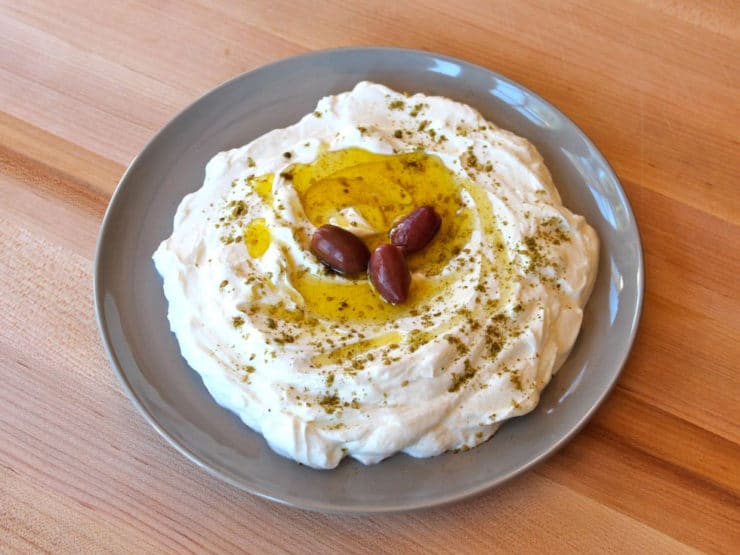
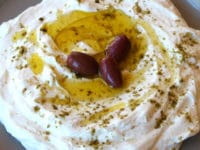
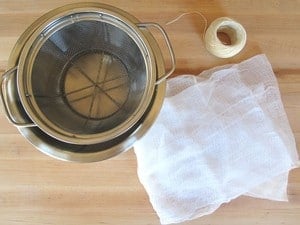
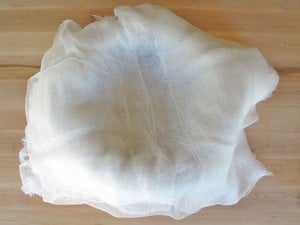
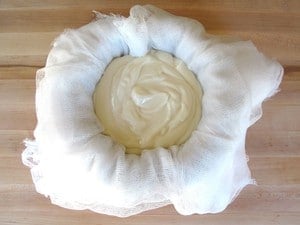
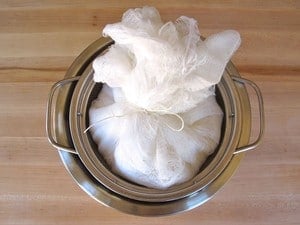
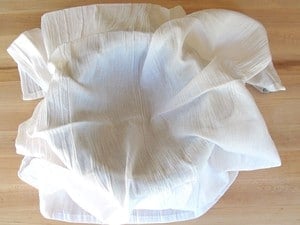

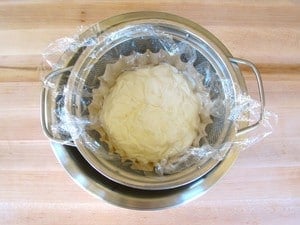
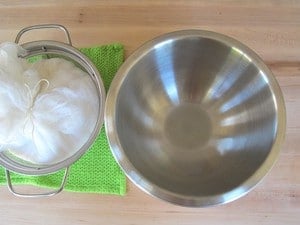
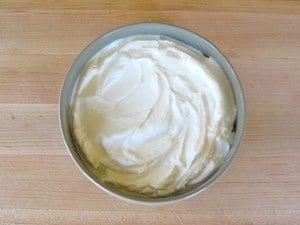
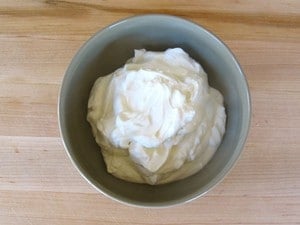
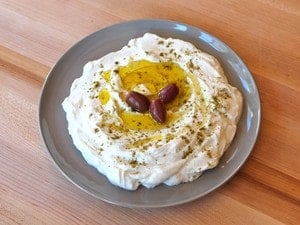


Can spices be stirred into yogurt prior to straining
Any additions should be made after straining, because the yogurt will lose volume and the flavor balance will be thrown off.
Thank you for your help with the straining process and information. I used greek plain yogurt that turned out great! What is the spice that you have sprinkled on the top of the yogurt cheese.
It’s an herb and spice blend called za’atar that is very popular in the Middle East. Main ingredients are hyssop herb and sesame.
I made my own yogurt, but when straining I cannot get it to thicken and separate into whey. Only thin yogurt goes through. Help!
Catherine, that sounds like a yogurt problem, not a straining problem. If your yogurt is too watery that will be a problem. My guess is you’re not keeping your milk warm enough when “fermenting“ your yogurt, or you’re not letting it ferment long enough.
Thanks for the helpful information. I just put my yogurt in the frig and plan to leave it til it is very thick. I tied it in the cheesecloth. Can the cheesecloth be reused when cleaned and dried?
Of course you can! I reuse mine all the time. If in doubt, wash, rinse, boil, ring out then dry in the sun. Can’t get much more sterile than that !!!
Thanks for the info…mother used to strain homemade yogurt (luban) in a cheesecloth bag…now everything is called Greek yogurt?I realize it’s not quite as thick as labneh cheese but is thinner…we lebanese folks make homemade luban and labneh cheese..I buy the cheese at a store called Global Foods….i only eat the plain…now my question…I want to buy the regular and strain it myself…so will it still have the same different prob
iotic benefits as listed on the store bought labneh
Have you done this with fat free yogurt?
Hi, I loved your post but just wanted to clarify that for strained yogurt to actually be considered “labneh” it has to be salted first otherwise it’s just a thicker greek yogurt not labneh. Labneh is SALTED strained yogurt.
source: i have a Lebanese mom and she along with everyone i know add salt to make homemade labneh as is the tradition in lebanon. (labneh is lebanese/levantine)
Anyway, your post is very helpful so thank youuuuuu :))x
Thanks for the info. I just got into yogurt making this last December. Yogurt making has become quite an unexpected staple of my home culinary passion. I’ve been straining my recent 2-qt batch for over 3 hours now, and it resembles Greek yogurt to some degree, but I’m just wondering about a time frame for how much longer it will take to make the good stuff. And thank you for informing me that I was sending all the whey down the sink when I could have been drinking it instead. Not a mistake to make next time.
It looks yummy. I must try it. Thanks much for sharing.
I was planning to prepare lebneh at home and your post really helped me. Thanks a lot Tori.
IMO you are way off on the yogurt/whey ratio.
I use 3 quarts homemade whole-milk yogurt to make 1 quart Greek or 4 quarts to make 1 quart labneh! I use a 50 micron nylon filter bag. So the economics aren’t quite so favorable as might seem especially if you use premium organic milk but you certainly can still come out ahead if you are willing to use supermarket milk. Needless to say buy in gallon containers. I buy 2 gallons and make 6 quarts yogurt and have 1/2 gallon for household use. Then I turn 4 quarts yogurt into 1 Labneh and am left with 2 quarts yogurt for breakfasts. . 6 quarts is what will fit in my sous-vide tank which is a great foolproof way if you have one.
One can only guess about store-bought yogurt, but you can approximate based on protein values. A good quality natural Greek yogurt (like Fage) probably uses 2 to 2 1/2quarts yogurt to make 1 Greek. Lesser brands may use as little as 1 and 1/2 and then use stabilizers to hold it together.
Look at the protein, it varies widely brand to brand! Only compare like fat contents though. Compare whole to whole, 2% to 2% etc.
Labneh should have salt added just before straining. The recipient I most commonly see is 3/4 tsp per quart (of yogurt before straining). The salt acts as a preservative and is expected for the traditional taste.
(Just speculation) I’d guess the reason for the salt is that it is not liquid enough after straining to maintain an anaerobic environment and the salt will help prevent invasion by aerobic bacteria and mold. I store it in mason jars, and you really have to press it down with a spoon to eliminate air gaps! I vacuum-pack for good measure (the fantastic $5 Foodsaver mason jar accessory!). I keep unstrained yogurt a month this way lord knows how long the Labneh might last!
I put some of the unstrained in a half-pint jar and seal it for starter. Put it in the fridge sealed and untouched for a month and it has never failed. I have seen advice to use starter within a week. P’shaw!
I’m trying room-temperature straining for the first time. I do understand why you can’t recommend it. It still turns out nicely in the fridge though.
Cucumbers and dill at ready!
Is there any reason I can’t repurpose some 100% bamboo pillow case material for straining? It’s thin, thinner than most tee shirts but fairly tightly woven. Thanks for any help on this.
Hi KC, I think it would probably work (as long as it’s clean!). The only issue might be if it is too tightly woven, it won’t strain quickly enough. The only way you’ll know is to try. Good luck!
FINALLY! I was very close to giving up on my homemade yogurt, because it always turned out super runny and difficult to eat. Too thin to strain through several layers of cheesecloth even. So this article was super helpful because it brought me back to the basics– I am straining my yogurt juice through a thin tea towel set in a metal strainer. I am so happy to be able to have a thick tasty yogurt! Thank you thank you thank you!
Great Peggy! Happy it was helpful.
Love your recipes. I used Chobani non fat yogurt and got about a quarter to 1/2 cup of whey after straining it for the recommended amount of time. I even let it strain one hour longer. Do some yogurt have more moisture than others which would benefit from straining, or are some yogurt labels thick enough so that one does not need straining. I was going to make Tsatsiki.
Thanks
Hi Daniel, yes– yogurts vary quite a bit by label and some naturally have more moisture than others. Chobani is a Greek yogurt, I believe, so it is already strained and won’t have a lot of additional liquid to strain out. The best way to figure out if it’s strained enough is to stir the yogurt and take a taste. Is the consistency thick and creamy? If not, you can continue to strain longer. It’s really a texture and taste sort of thing. For tzatziki I find a texture that is slightly thicker and creamier than Greek yogurt works best for me (others like it more liquid but I prefer nice and thick)– so if you’ve strained the Greek yogurt and got 1/2 cup of whey, it’s probably just about right!
Just discovered your site today while looking for pictographic recipes for Falafels.. Now I found all the sauces and Greek yogurt too!!! Very excited to try out the whole shebang tomorrow.
Couldn’t get enough of Greek yogurt on my trip to Greece and haven’t found it available I’m stores here in India. Definitely going to try making my own now!
Keep up the good work!
I live in Ho Chi Minh City, Vietnam and was getting ready to make my own yogurt when I found some greek yogurt in a local gourmet store. I’ll use that as a starter and will strain it to make it thicker. I’ve been making yogurt myself here but using the local yogurt yields a mediocre product, although I must admit my culturing method has been to add a cup or two of yogurt to about a liter of milk and leave it covered in a warm room for 2 to 4 days. I end up with a product that tastes almost like buttermilk or drinkable yogurt and is quite good. I grew up in the dairy industry so I have no adversion to cultured products, the thicker the better. Now that I have a good starter and a thermometer, I may even make some sour cream. Our dairy had great sour cream, but the starter was a culture that was over 25 years old. I’m working with much less flavorful cultures and don’t want to add vinegar to kick start the acidity. I’ll go the natural way, and if I can find sour cream somewhere in town, I’ll use that. It is fun, the end products are very interesting if not very consistent, and I get to taste many thicknesses and flavors of homemade yogurt.
Vietnamese people seem to be somewhat lactose intolerant, but I think it is psychological rather than physical. My wife can’t eat cheese or butter without feeling mentally nauseated but she can eat ice cream, cup yogurt that is frozen, and drink coffee with sweetened condensed milk (because she says it is not milk). The people here are just beginning to drink more milk and eat cheeses, so I would expect that the newer generations will add weight and height as their consumption of dairy (besides ice cream) increases.
I enjoy your site and suggestions. Keep it up, its very interesting!
Thanks Bill. I too am a big fan of cultured dairy, it’s the ancient way of getting calcium, protein and healthy probiotics into our system. I feel badly for people who can’t handle lactose, I don’t know what I’d do without my yogurt and cheese!
You can buy strainers like that through pampered chef as well, that’s what mine are.
Hi,
Could you please tell me who makes the strainer you used in the photos? I’m having a hard time finding one in that size with two handles instead of the one long one.
Thanks!
Hi Jenn, I bought these several years ago. I think I got them at Sur La Table… not sure though!
Hi Tori
Turns out I have been making this for a while now and not knowing what I was doing. Out of necessity I froze a container of Lemon Yogurt. When I thawed it out I noticed that there was a lot of water in the container so I drained it out and noticed the remaining yogurt was quite thick. Whipped it up with a cup of frozen desert topping (CoolWhip) and put it into a graham cracker crust topped with more CoolWhip and put back in the freezer. Topped with fresh blueberries and served and it was a hit. Next time I will just use your method and save the freezing until it is done.
Interesting Tim!
Nice blog. I do not understand why it is called Greek Yogurt where everywhere in this World called “Turkish Yogurt” or Yogurt. One other thing never understood is “Frozen Yogurt” that has nothing to do with Yogurt! It is better called ” Low fat Ice cream” Or Nonfat Ice Cream.
I have to say I’ve only ever heard it called Greek yoghurt, never “Turkish yoghurt”, maybe “Turkish yoghurt” and “Greek yoghurt” are local terms, respectively.
Hi,
I’ve strained the yogurt and created my own concoction, but I’m still waiting for the Labneh recipe.
Hi
This looks great, one question, whilst straining should you keep in the fridge or just at room tempertature? thanks 🙂
I refrigerate it. 🙂